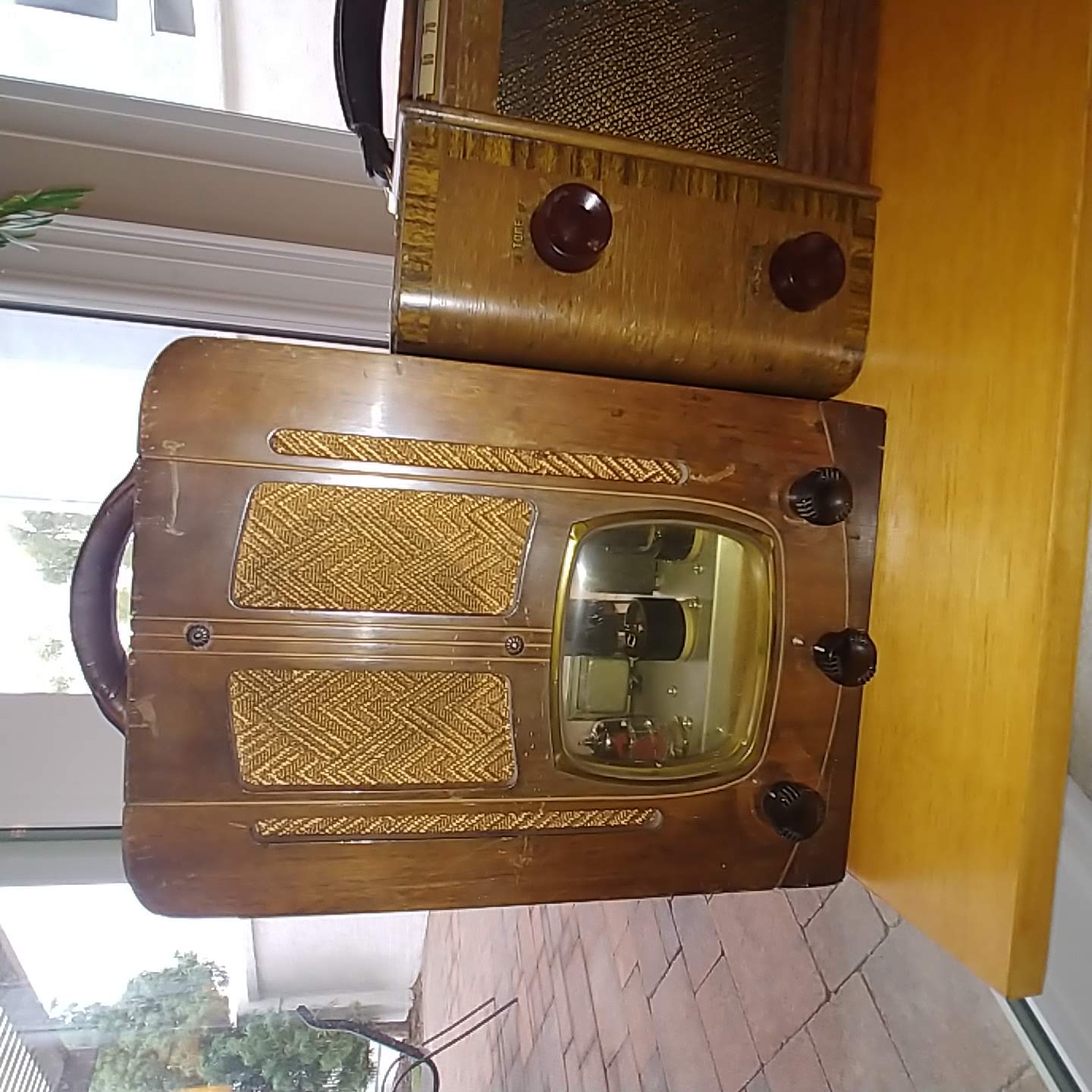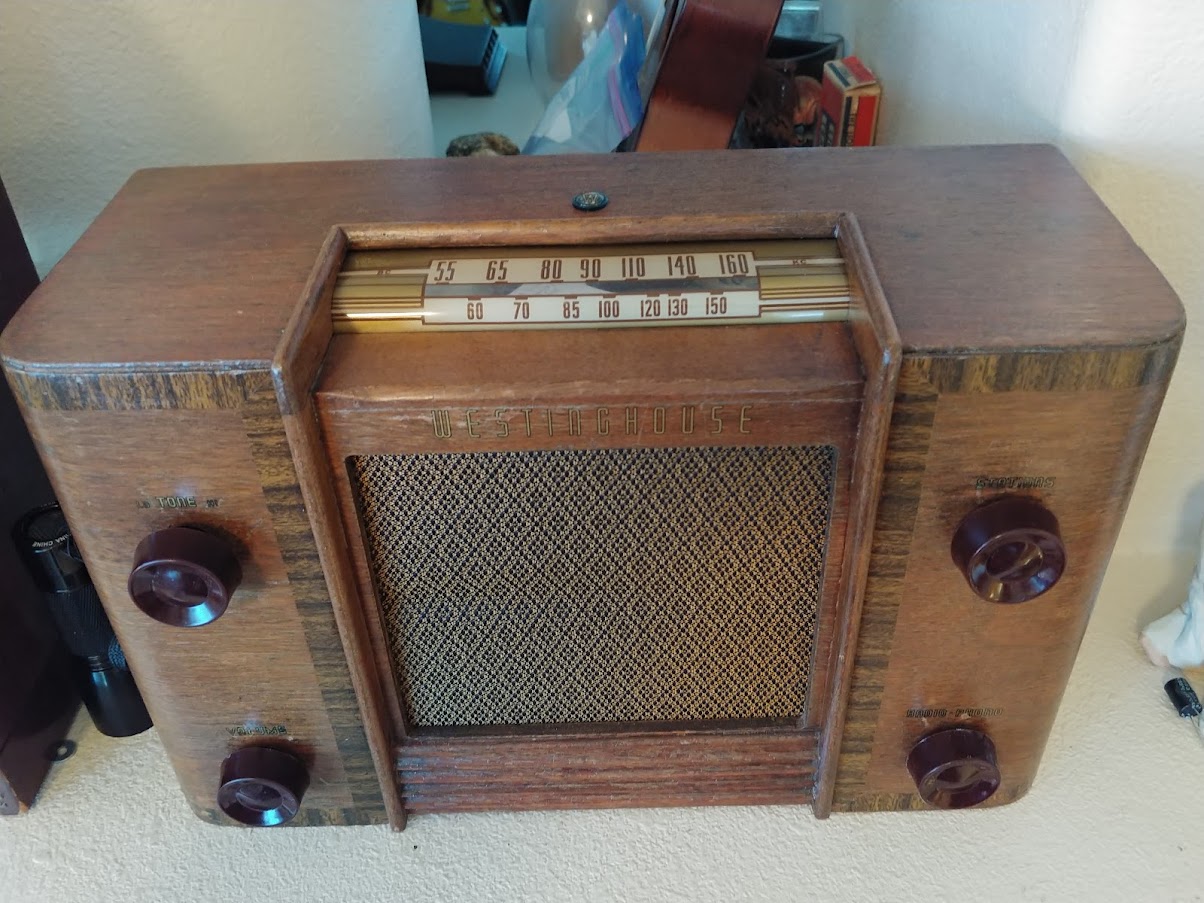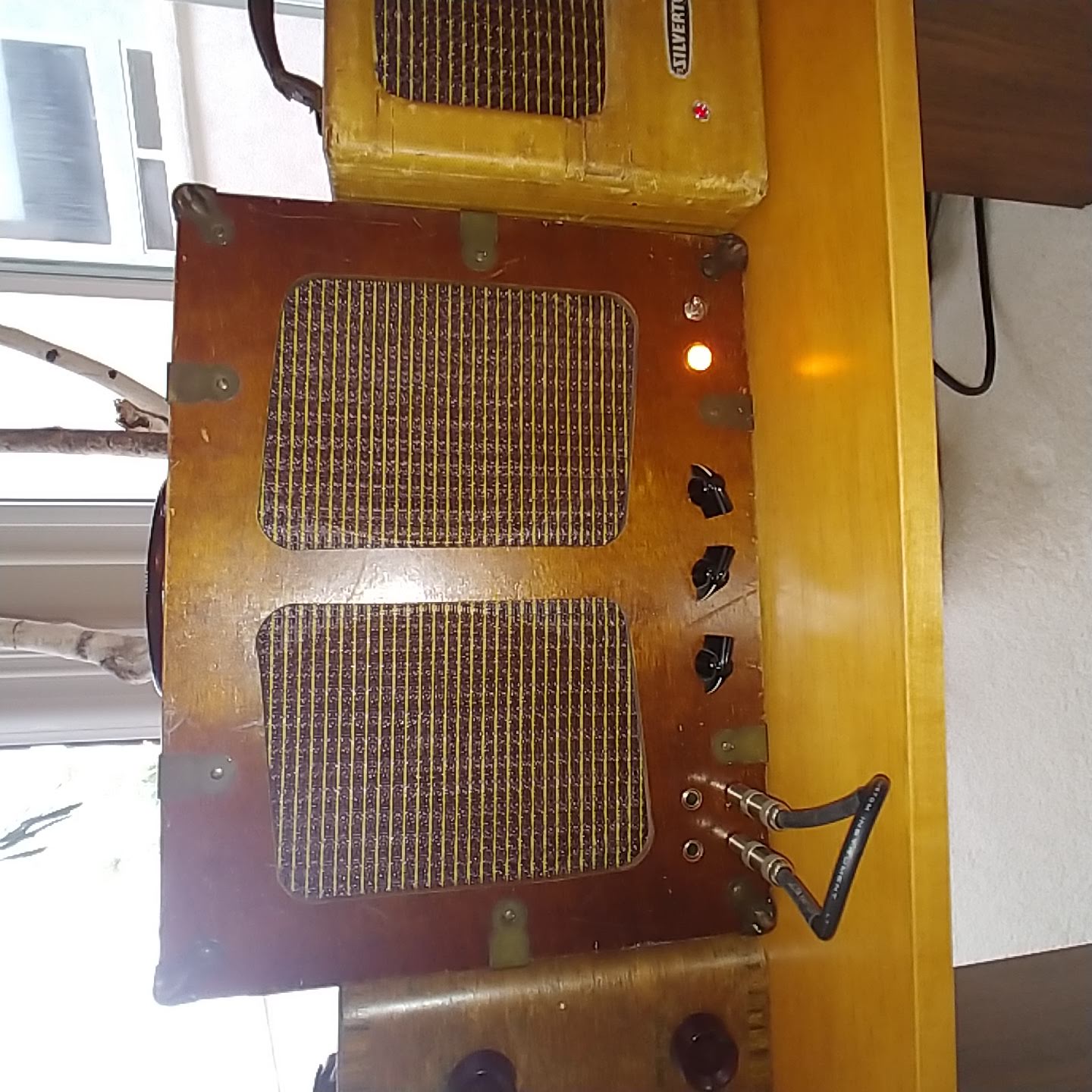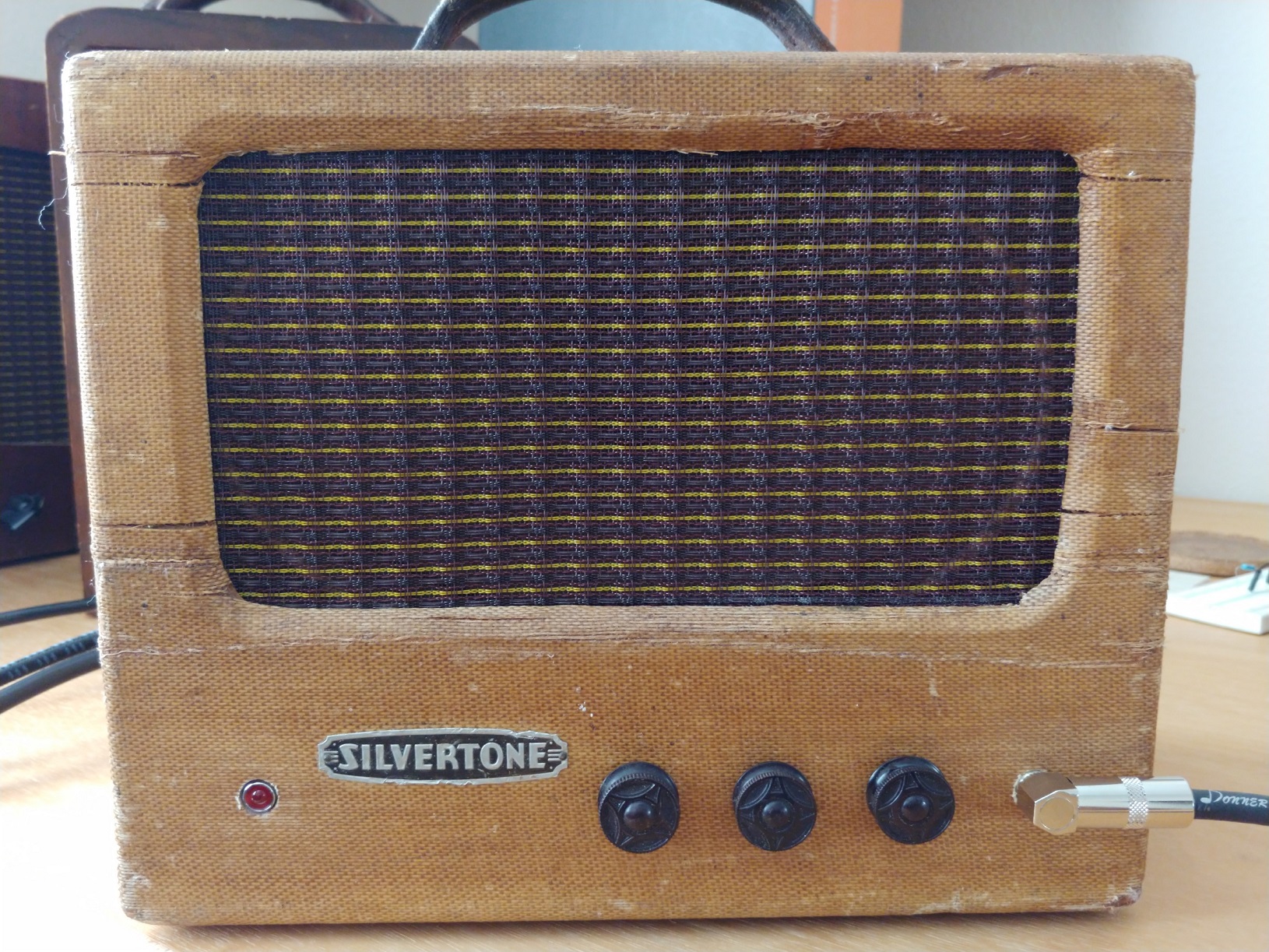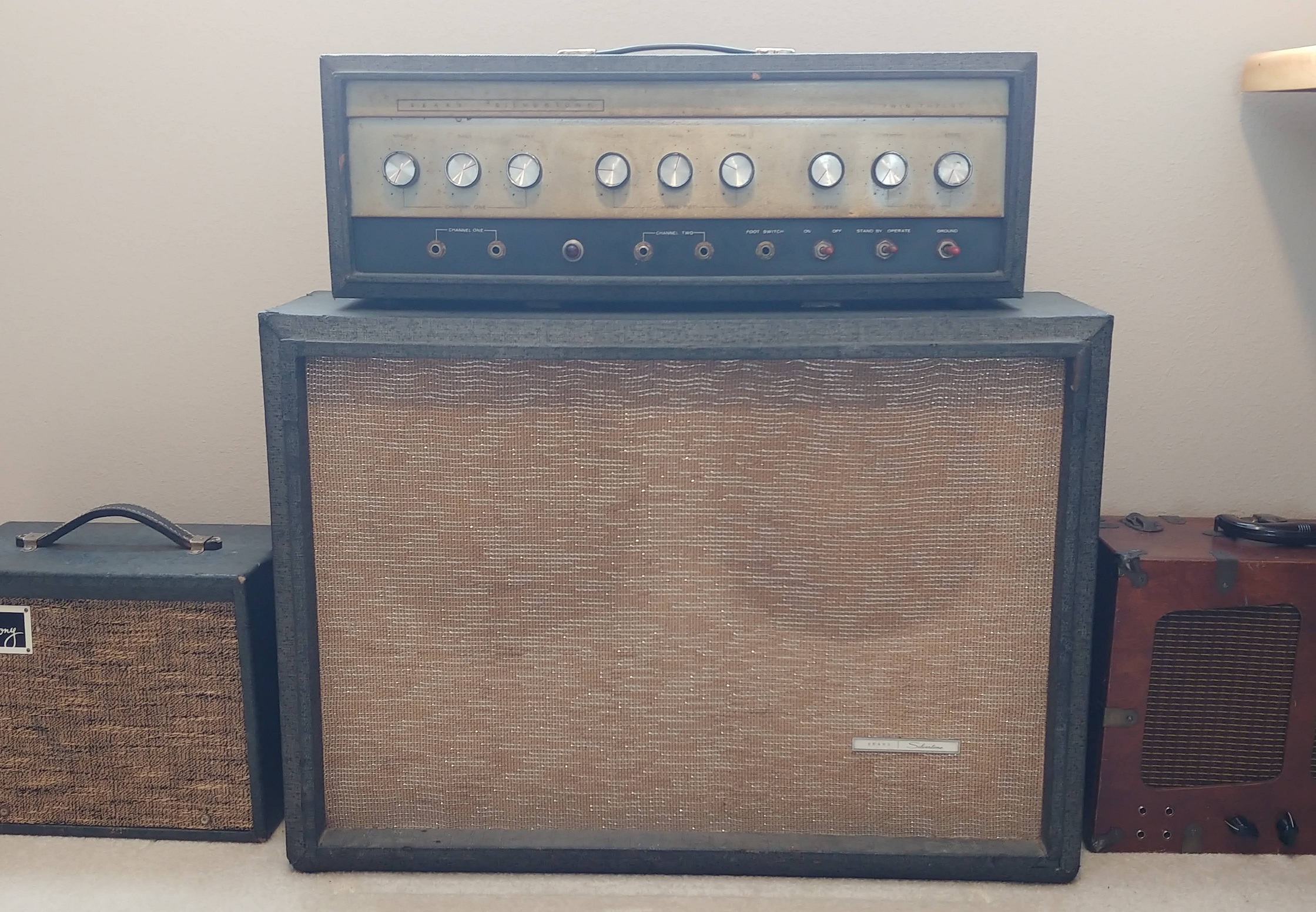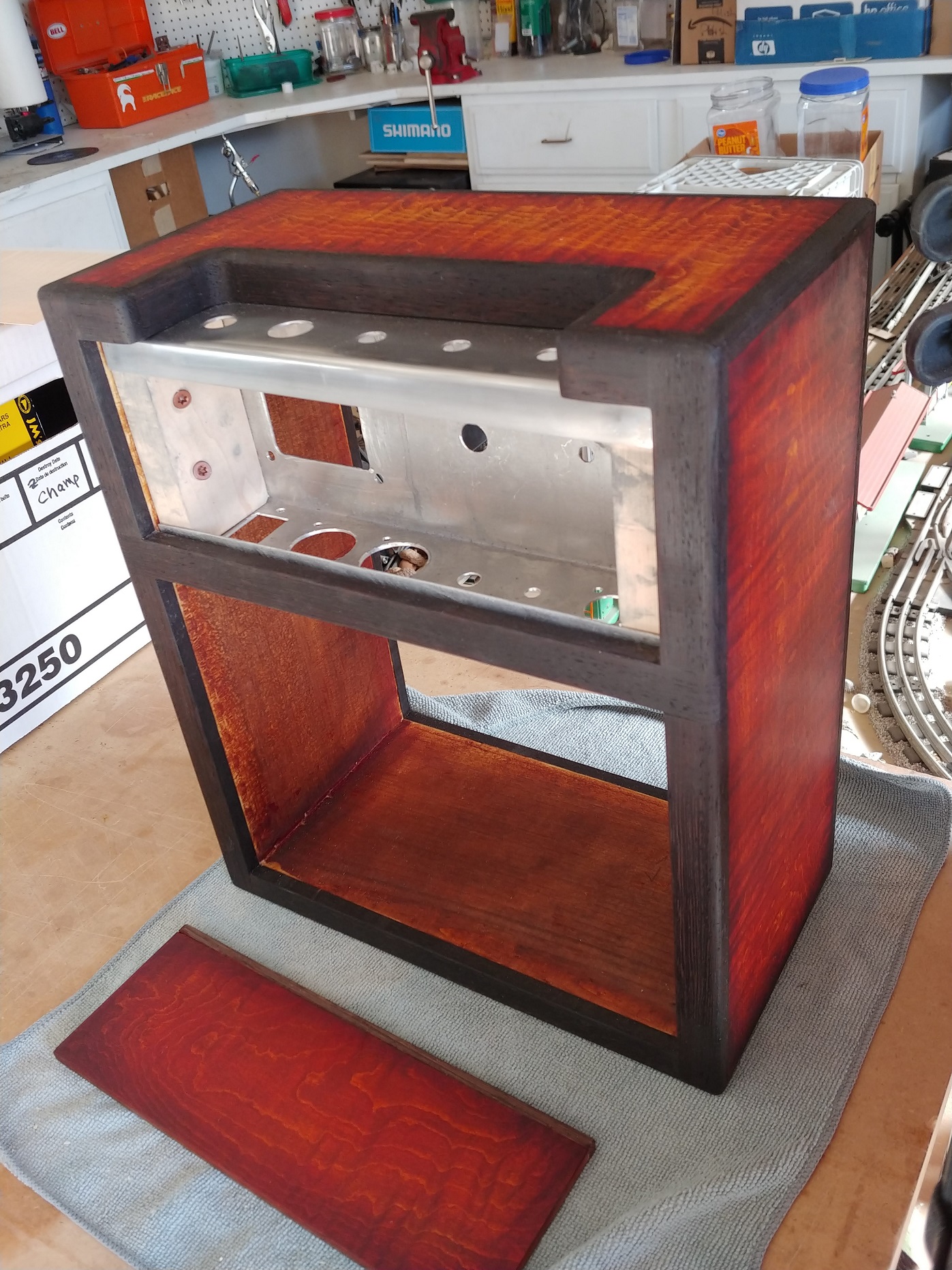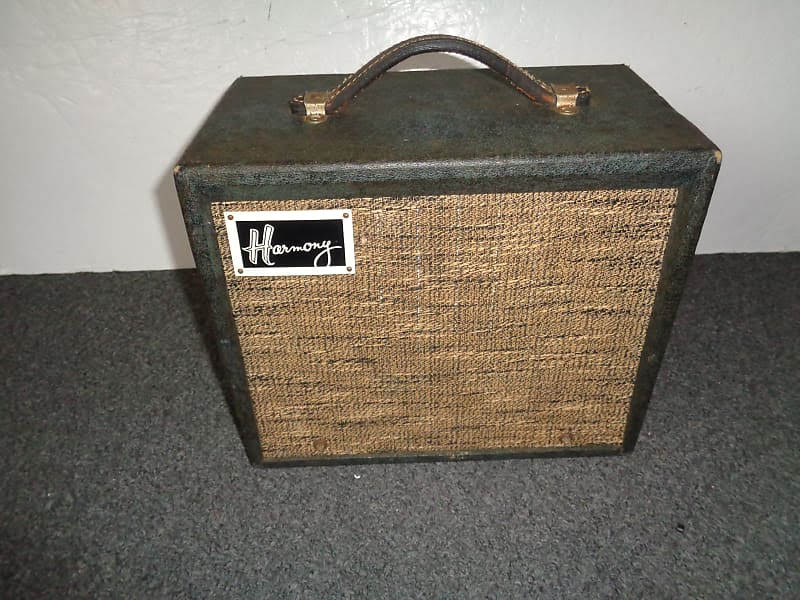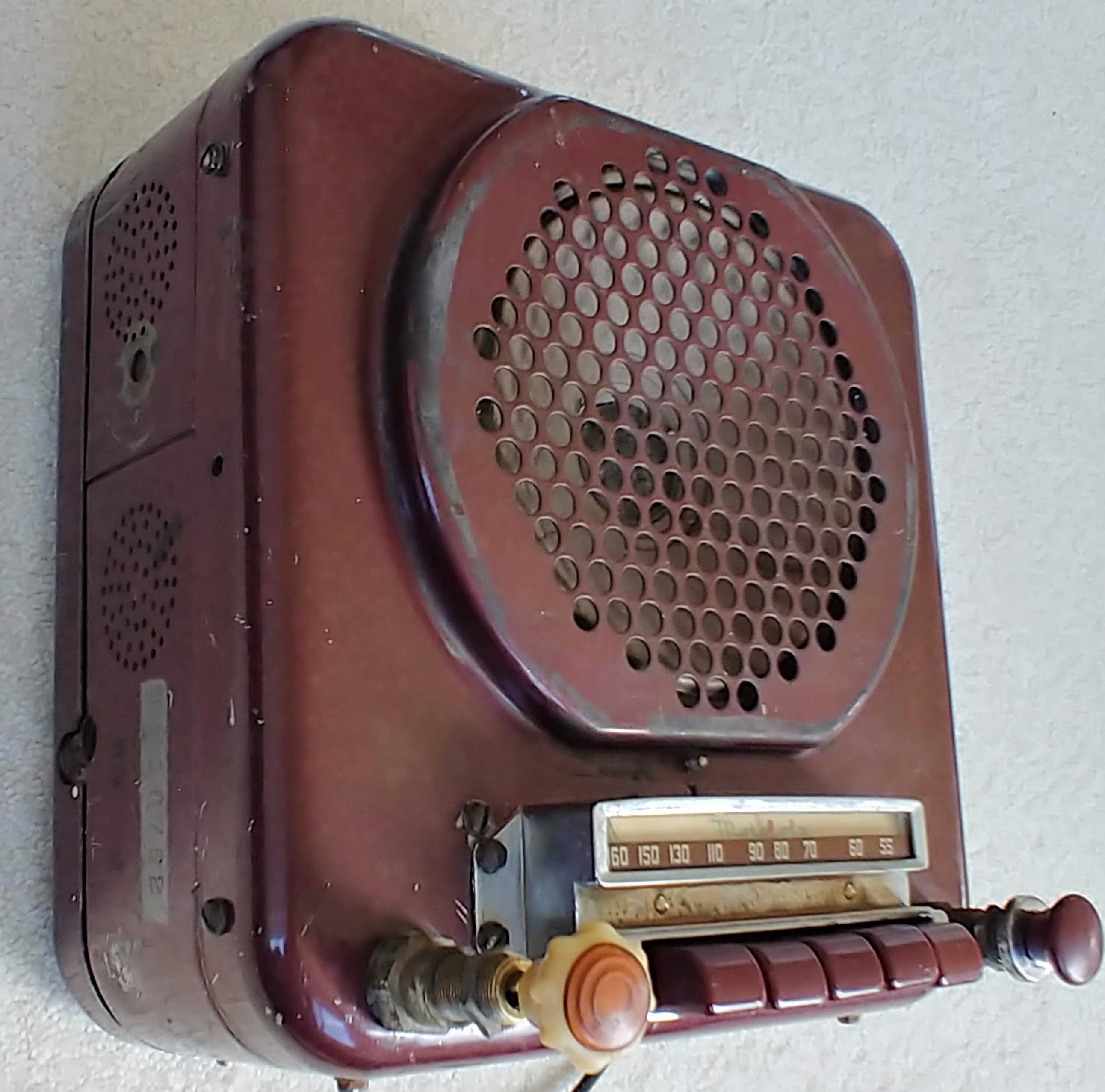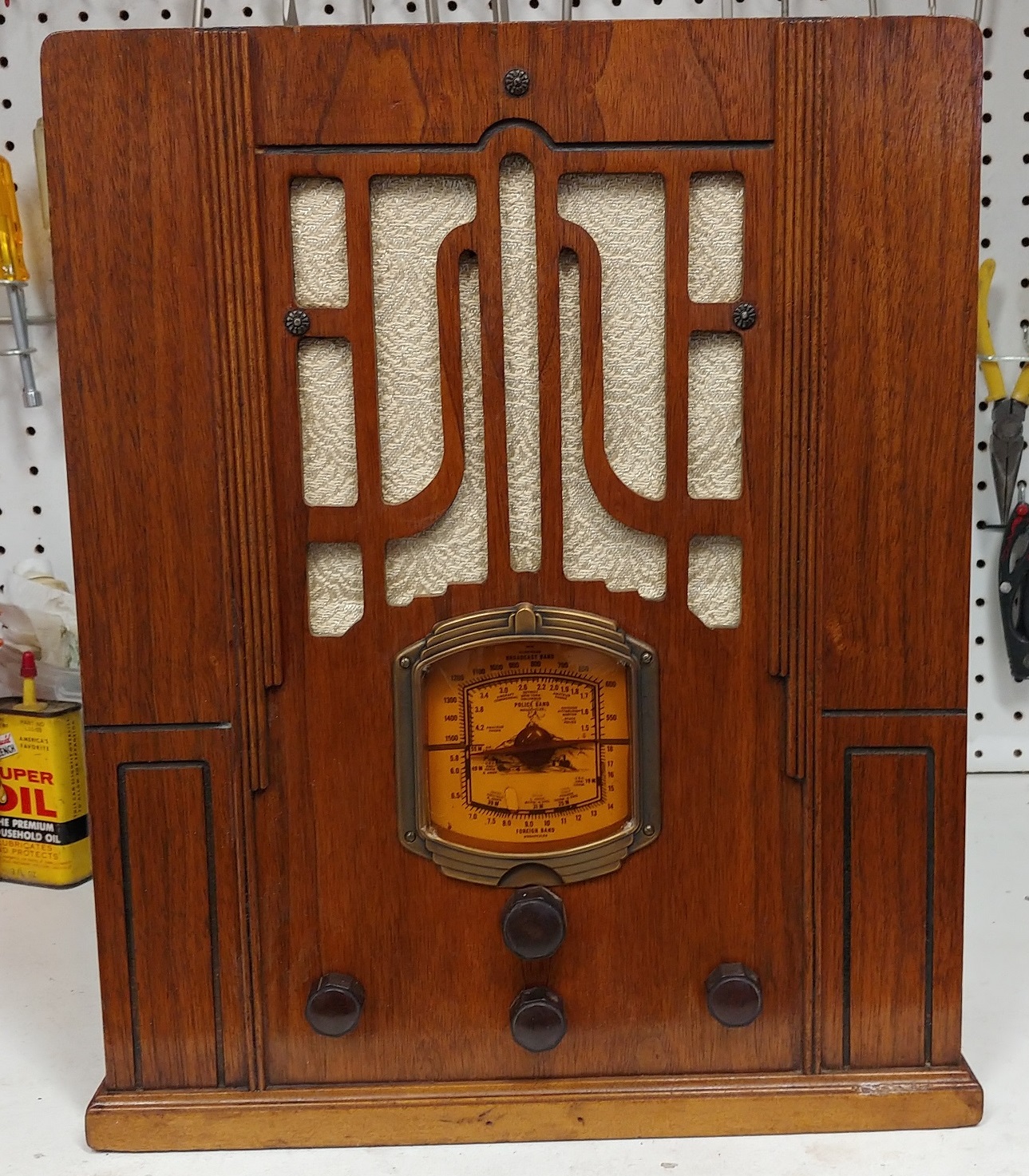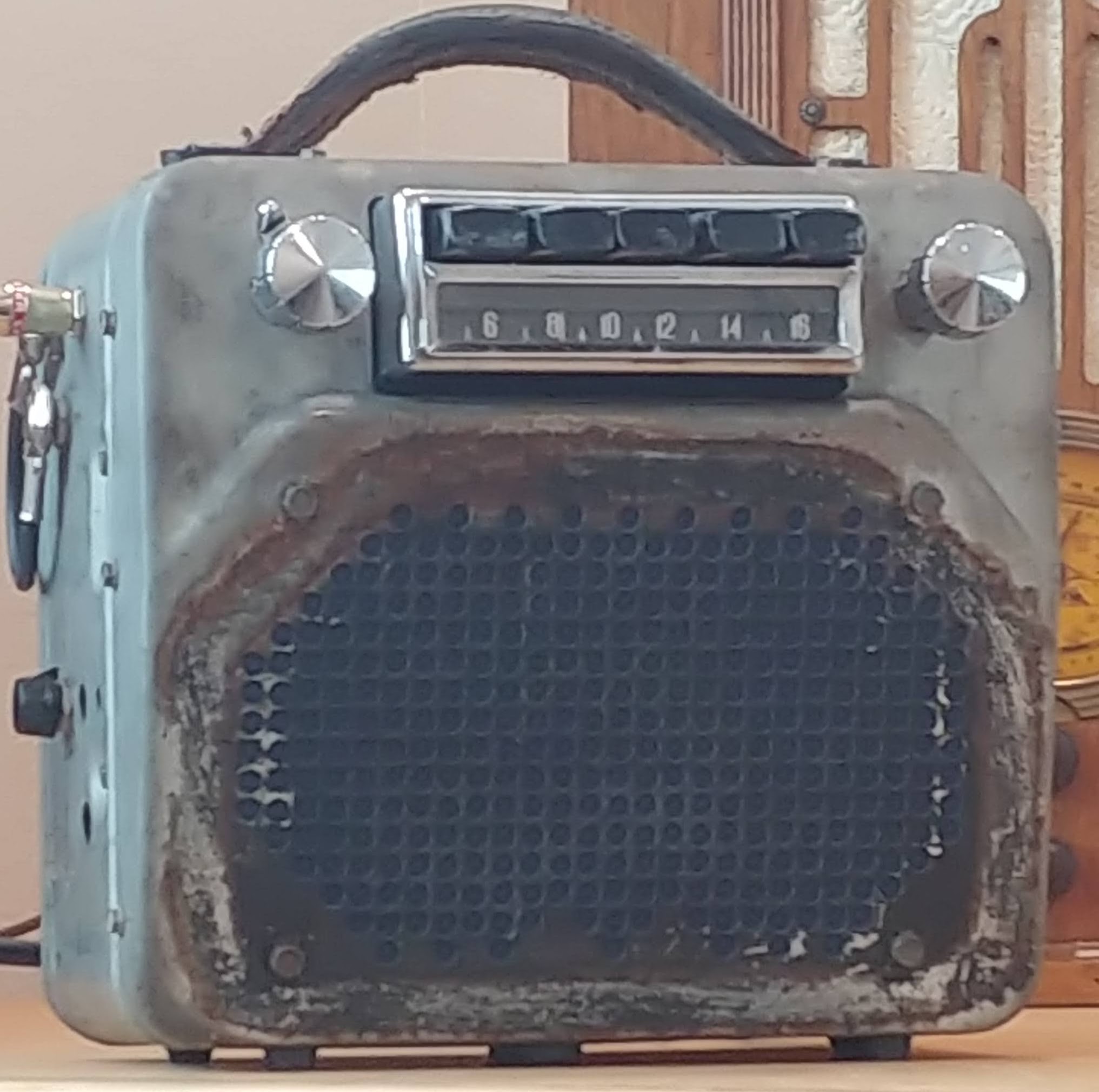
The Black & Blues (Serial #05) is a one of a kind tube guitar amplifier built in a 1952 Packard radio made by Delco. The amp is an all metal chassis and cabinet with an amazing original patina that is built like a tank. This great sounding amp is perfect for use as a small stage performer or for studio recording. Original knobs and working pushbuttons with a lighted dial and blue LED pilot light. Vintage period correct leather handle. The Black and Blues is an extremely compact layout of a guitar amplifier in the style of the original Packard car radio that delivers incredible vintage tone and volume. Exceptional amount of clean headroom but can get super crunchy when the volume is cranked. This amp delivers bell-like tones that sound very piano-like, a testimony to the circuit design.The volume can be adjusted to manageable levels with the built in master volume and sound with the tone control. Can be used as a combo amp with its built in speaker or as a head when connected to an external speaker cabinet.
The Packard Radio and Car
The radio was originally in a 1952 Packard and might have been included in many models https://en.wikipedia.org/wiki/Packard#1946%E2%80%931956 However, being made by Delco which is a subsidiary of GM, the radio might have also been included in other GM cars such as Buick and Chevy.
The radio is a Model: 416387 Packard - United Motors Service Delco. The radio was a Superhet with RF-stage; ZF/IF 260 kHz; 2 AF stage(s) that used 8 tubes. The basic principle of 6 volt dc car radios was used. The 6v DC was run through a mechanical vubrator which created alternating voltage that then could be run through a step up transformer to get high voltage DC to run the vacuum tubes. The radio would draw typically 9amps of current. The radio had 7 AM Tuned circuits for broadcast. The speaker was a Permanent Magnet Dynamic Loudspeaker with moving coil elliptical in shape (6x9”). It used Push-pull for the output stage. Additional info Rider's Perpetual, Volume 21, Copyright 1950.
The Radio in the car dashboard
The 1952 Packard 200 car, and example of the car this radio might have been installed
Original Buick Radio Schematic
The original radio circuit included 6V6 output tubes in push pull configuration. The 6V6 were the only glass tubes in the Buick radio. The plan was to use these Delco tubes for the Guitar amp, but the tubes were not as musical as the other tubes that were used in the amp. The radio volume/tone pot and switch combo was used in the amp because it was a perfect fit and close enough values for the amp design. The other radio parts were not able to be used in the amp and so were added to the salvage pile to be used in other projects.
Inspiration
Building modern guitar amps out of vintage radio chassis and cabinets is a passion and having an amp in a metal car radio with natural patina seemed like a cool idea. The car radio is small in size and bullet proof with its metal case. The radio layout is quite compact and includes an ideal power amp with push pull 6V6 tubes, A vintage 6x9” Jensen organ speaker with larger magnet and voiced for music fits perfectly and would give that guitar vibe from the 1940’s and 50’s when odd-ball amps used 6x9 speaker for harp and guitar. Removing the original vibrator, power transformer and output transformer would provide enough space for the modern iron. The front panel had a lot of blackened patina and the blues is the heart of this amp, so it is named “Black and Blues”. Build serial number 5 for StillAmp’d completes the tag.
The Design
This design follows early 6v6 push pull guitar amps with an all octal tube set in order to preserve the original all octal radio design. A lot of thought went into possibly using the original tube set from the radio, but there were no existing guitar amps that used them, so except for the 6V6 tubes a different tube set was used for the preamp and phase inverter. It was decided to build the early Fender Deluxe 5C3 which used a 6SC7 preamp triode, a 6SC7 Phase inverter and 6V6 push pull power stage. But rather than build two triode channels, I wanted to design a pentode preamp channel. It was decided to go with the Gibson BR6F which used a 6SJ5 pentode into a 6SN7 phase inverter into the 6V6 push pull. It was decided to use the 6SC7 for the PI.
Dual channel all octal vintage 6 tube guitar amplifier. Channel 1 represents the 1952 Fender 5C3 tweed deluxe circuit using 6SC7G glass triode preamp. Channel 2 models the 1945 Gibson BF125 circuit with 6SJ7G glass pentode preamp. Phase inverter stage uses a dual triode 6SC7G. Output stage is push-pull 6v6G delivering 14 watts into 6x9 original 1950’s Jensen Alnico Speaker. Incorporating the 5Y3 rectifier tube for vintage tonal behavior via the power supply. High quality vintage style Hammond power and output transformers. The Black and Blues has a switchable 4, 8, or 16 ohm external speaker that automatically disconnects the internal speaker.
The Black and Blues amp is a great looking vintage guitar amp. It sounds great and is easy to transport. Extremely sturdy. The knobs are original to the radio from which the amp was created. The push buttons work as well as the tuning dial, although they do not obviously bring in radio stations, just for the fidgeter in us all.
The Jensen 6x9 alnico speaker from the 50’s sounds fantastic. The Matched RCA output tubes are very musical and low noise, improvement over the OEM Delco 6V6
Notice the tube heater wires are back and blue :-, just like the amp. And the blue light bulb for the dial is a great and subtle effect in a darkened room. There is a blue LED pilot on top to show when the amp is on.
Servicing the amp is very straightforward as both the front and rear panels are designed to be removable with adequate access room.
The Circuit
Power Supply Filter Choke
It was decided to use a filter choke from an old Webster-Chicago 2010 reel-to-reel recorder. The 2010 has a similar complement of tubes and so this would allow for a choke to be used as the first filter. The use of a choke is that it will provide a smoother DC voltage and hence less hum. Since the 2010 had the 6V6 plate voltage after the choke, it is likely that the choke would support the current draw of the entire Amp and thus all DC voltages would get the choke filtering. Some early Fender amps that used 6L6 in push-pull had tapped the plate voltage before the choke but then the 6L6 draws twice the current (200ma vs 100ma for the 6V6) and hence would need a much larger choke. The only Fender 6L6 that tapped plate after the choke was the Bassman 5E6 (5E6-A). Most Fender 6V6 with choke tapped plate after the choke as is designed with the Black and Blues.
Pentode Preamp
Some great information at this link, http://www.valvewizard.co.uk/pentode.html
The 6SJ7 used in the Black and Blues is perfect, no microphics and very musical, almost piano like. It is designed much as the Gibson BR6F except the screen bypass cap is connected to the cathode rather than to ground.
Pentode Screen Bypass Capacitor
The screen bypass capacitor serves a similar purpose as the cathode bypass capacitor: it holds the screen voltage steady to prevent internal negative feedback from reducing gain. However, in the same way as for the cathode, the capacitor can be made small in value to boost higher frequencies, or omitted completely to reduce gain and increase headroom. Many traditional guitar amp designs do not include this capacitor at all. In general, the screen bypass capacitor has a greater effect on the gain of the pentode than the cathode bypass capacitor. The screen bypass capacitor should always be connected to the cathode rather than to ground. Yes, I know a lot of circuits connect it to ground and get away with it, but it is bad practice.
Cathode Bias 6SC7
The original Deluxe 5C3 uses Grid Leak Biased 6SC7, but according to Rob Robinette this is archaic design and leads to potential issues when guitar inputs are on the hot side (pickups or pedals as described this link https://robrobinette.com/Fender_Deluxe_Models.htm ). So, it was decided to use the Cathode Bias 6SC7 from the Fender 26 Deluxe, This is reflected in the following diagram and in the “Build Schematic” that follows. The values for the Cathode Bias resistor 2.5K and capacitor 25uf were adopted from the 6SC7 Phase Inverter.
The Webster
The reel-to-reel Webster was another inspiration for the Black and Blues. The Power transformer and 6X5 rectifier from the Webster were originally installed but the voltage and current was not enough to get the headroom that was desired, so they were replaced by the 270DX and the 5Y3. Also the Webster output transformer was also installed initially but it was decided to add an impedance options and so was replaced with the 1760E.
The Build Schematic
Fender 5C3 Schematic
Gibson BR6F
The Layout
The amp needed a handle, so a vintage leather handle was sourced and installed on top.
The original radio dial lights were kept intact with blue light and are really cool in a dark environment; but it is very subtle and so a brighter blue LED was added to the top. The original radio components including vibrator, power transformer, and output transformer were removed to make room for the guitar amp PT and OT. The radio Rectifier tube was a perfect location for the 5Y3
Improved Changes
Taming Vibration
Once complete, certain note harmonics caused vibration of the grill. The vibration is not present when the speaker baffle plate is removed. It was decided to isolate the speaker from the chassis with large rubber gaskets (guitar strap locks). In addition, a metal strap was fabricated to extend across two speaker mounting bolts across the inside of the speaker. A couple of foam blocks were inserted between the strap and the grill so that pressure is applied to the grill preventing it from vibrating. Works great and is not visible.
